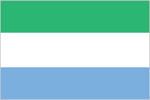Compare
Falkland Islands
to
Sierra Leoneto
Sierra LeoneThe GDP per capita in Sierra Leone is $1,400 while in Falkland Islands it is $55,400
This entry shows GDP on a purchasing power parity basis divided by population as of 1 July for the same year. A nation's GDP at purchasing power parity (PPP) exchange rates is the sum value of all goods and services produced in the country valued at prices prevailing in the United States. This is the measure most economists prefer when looking at per-capita welfare and when comparing living conditions or use of resources across countries. The measure is difficult to compute, as a US dollar value has to be assigned to all goods and services in the country regardless of whether these goods and services have a direct equivalent in the United States (for example, the value of an ox-cart or non-US military equipment); as a result, PPP estimates for some countries are based on a small and sometimes different set of goods and services. In addition, many countries do not formally participate in the World Bank's PPP project that calculates these measures, so the resulting GDP estimates for these countries may lack precision. For many developing countries, PPP-based GDP measures are multiples of the official exchange rate (OER) measure. The differences between the OER- and PPP-denominated GDP values for most of the wealthy industrialized countries are generally much smaller.
Source:
CIA World Factbook
The per capita consumption of electricity in Falkland Islands is 6,221kWh while in Sierra Leone it is 23kWh
This entry consists of total electricity generated annually plus imports and minus exports, expressed in kilowatt-hours. The discrepancy between the amount of electricity generated and/or imported and the amount consumed and/or exported is accounted for as loss in transmission and distribution.
Source:
CIA World Factbook
Falkland Islands consumes 4.4352 gallons of oil per day per capita while Sierra Leone consumes 0.0630
This entry is the total oil consumed in gallons per day (gal/day) divided by the population. The discrepancy between the amount of oil produced and/or imported and the amount consumed and/or exported is due to the omission of stock changes, refinery gains, and other complicating factors.
Source:
CIA World Factbook
 With its 5,743,725 people, Sierra Leone is the
111th largest country in the world by
population. It is the 119th largest country in the
world by area with 71,740 square kilometers.
With its 5,743,725 people, Sierra Leone is the
111th largest country in the world by
population. It is the 119th largest country in the
world by area with 71,740 square kilometers.
Democracy is slowly being reestablished after the civil war from 1991 to 2002 that resulted in tens of thousands of deaths and the displacement of more than 2 million people (about a third of the population). The military, which took over full responsibility for security following the departure of UN peacekeepers at the end of 2005, is increasingly developing as a guarantor of the country's stability. The armed forces remained on the sideline during the 2007 and 2012 national elections, and over the past year have deployed over 850 peacekeepers in the African Union Mission in Somalia (AMISOM). As of January 2014, Sierra Leone also fielded 122 staff for five UN peacekeeping missions. In March 2014, the closure of the UN Integrated Peacebuilding Office in Sierra Leone (UNIPSIL) marked the end of more than 15 years of peacekeeping and political operations in Sierra Leone. The government's priorities include furthering development, creating jobs, and stamping out endemic corruption.
Check out the recommended reading list below for great sources of information on Sierra Leone